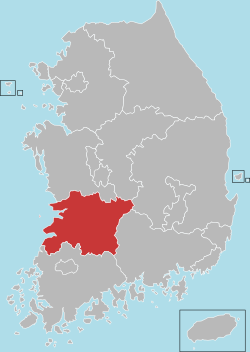Jeollabukdo
|
North Jeolla Province 전라북도 |
||
|---|---|---|
| Province | ||
| Korean transcription(s) | ||
| • Hangul | ||
| • Hanㅂ. | ||
| • McCune‑Reischauer | Chŏllabuk-to | |
| • Revised Romanization | Jeollabuk-do | |
|
||
 |
||
| Country | South Korea | |
| Region | Honam | |
| Capital | Jeonju | |
| Subdivisions | 6 cities; 8 counties | |
| Government | ||
| • Governor | Song ha-jin | |
| Area | ||
| • Total | 8,067 km2 (3,115 sq mi) | |
| Area rank | 7th | |
| Population (December, 2015) | ||
| • Total | 1,869,711 | |
| • Density | 232/km2 (600/sq mi) | |
| Metropolitan Symbols | ||
| • Flower | Zinnia | |
| • Tree | Ginkgo | |
| • Bird | Magpie | |
| ISO 3166 code | KR-45 | |
| Dialect | Jeolla | |
| Website | Travel Information | |
North Jeolla Province or Jeollabuk-do (전라북도; 全羅北道; Jeollabuk-do) is a province in the southwest of South Korea. The province was formed in 1896 from the northern half of the former Jeolla province, and remained a province of Korea until the country's division in 1945, then became part of South Korea. The provincial capital is located at Jeonju, which was the capital of all of Jeolla before 1896.
Jeollabuk-do has the most fertile fields in the Republic of Korea. Its mountains and fields have been a source of life, providing the fine foods of Korea. It is the hometown that preserves and passes down traditional Korean tastes, fashions and culture, and is a beautiful land filled with magnificent scenery and nature.
During the Proto-Three Kingdoms period, Jeolla region was the center of the Mahan confederacy among Samhan. There were 15 tribal countries out of 54 located in the region. During the period of the Three States, this region came to belong to Baekje when it absorbed Mahan. Baekje was destroyed by the Silla and Chinese Tang dynasty allied force in 660 (20th year of King Uija) and ruled by Tang. It became a part of Silla when Tang was expelled in 676 (16th year of King Munmu).
When there were 9 states and 5 small capitals in Unified Silla in 685, there were Wansan-ju (present Jeonju) and Namwon-gyeong (present Namwon) in Jeollabuk-do in existence.
In 892, when General Gyeon Hwon founded Hubaekje (later Baekje), this area continued to exist and was the center of the country for about 50 years. In 936, during the rule of Singeom, it was attributed to Goryeo Dynasty. From 900 to the time when Hubaekje was attributed to Goryeo, Wansan-ju (present Jeonju) had been its capital, and the country ruled the whole Jeolla-do region.
...
Wikipedia

